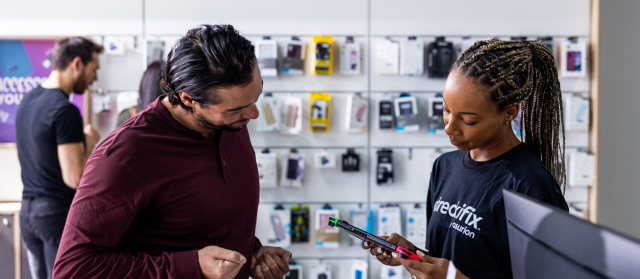Picture this: You power on your MacBook® setup, but there’s no response from your second monitor. It's not a pretty picture, is it?
Don’t worry, our experts at uBreakiFix® by Asurion have seen it all—and can fix it all. Here’s how to tackle a Mac not recognizing an external monitor.
Common causes of external display issues
Identifying the cause is the first step in resolving issues with your Mac® not connecting to an external monitor. The typical culprits are:
- Faulty or incompatible cables/adapters
- Incorrectly plugged-in cables
- Incorrect display settings
- Outdated macOS®
- Hardware issues

You can’t work when your computer doesn’t want to
Get it repaired fast at one of our stores. Just stop in or make an appointment⎯we'll handle the rest.
How to fix MacBook external display not detected
Here are some steps to troubleshoot and resolve the issue of your MacBook not detecting an external monitor.
1. Check the cables and adapters
Make sure you're using the correct cables and adapters for your Mac and monitor. Also, check your cables and adapters for any physical damage.
2. Check the hardware ports
Inspect the ports on your Mac and monitor for any signs of damage. Look for any physical damage or debris in the ports. If available, try using different ports on your Mac or monitor.
3. Make sure the cable connection is secure
Make sure all cables are plugged in correctly—and snuggly. The best way to test for proper connection is to simply unplug and reconnect all your cables.
4. Adjust the display settings
Tweaking your display settings can sometimes resolve the issue. You can also go the somewhat easier route and see if your Mac can find your external monitor. Here’s how to get your computer to detect displays:
- Click on the Apple menu.
- Select System Preferences > Displays. In the Displays section, click Detect Displays to help your Mac recognize the external monitor.
5. Update the macOS
Software updates help your computer to course-correct when faced with a known software issue or glitch. Make sure your MacBook is running the latest version of macOS with these steps:
- Go to the Apple menu.
- Select System Settings (or System Preferences) > Software Update. Depending on your software version, you’ll have to select General, then click Software Update.
- If there’s an available update, click Upgrade Now.
If you've tried these steps and still need a little help, we're right around the corner. Schedule a repair at the nearest uBreakiFix® by Asurion store and our certified experts can get your device back up and running as soon as the same day.

